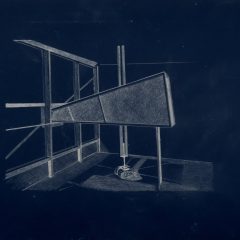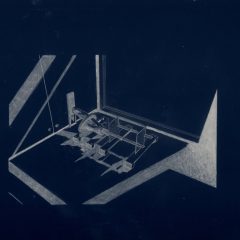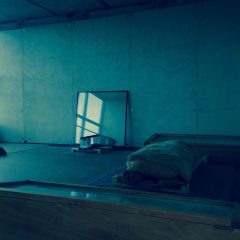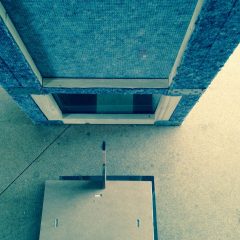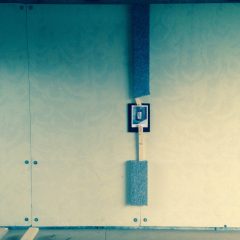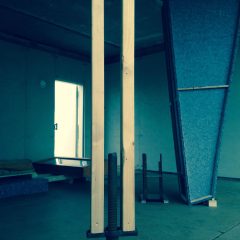SERIALITÄT UND ZYKLUS I.
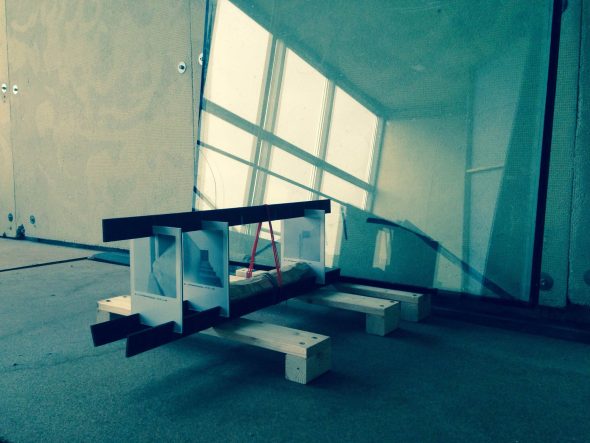
Zwischen Mai und Oktober 2016 wird die Plattenvereinigung auf dem Tempelhofer Feld in Berlin zu einer künstlerischen Werkstatt und einem Forum, das sich mit dem Thema “Serialität und Zyklus” auseinandersetzt. Für einige ausgewählte Künstlerinnen und Künstler wird das Gebäude zum Atelier und Ausstellungsraum für die Realisierung installativer Arbeiten, die sich aus unterschiedlichen Perspektiven mit “Serialität und Zyklus” auseinandersetzen. Die Installationen werden von einem Rahmenprogramm mit öffentlichen Vorträgen und Diskussionsveranstaltungen begleitet. Die künstlerischen Arbeiten werden sowohl vor Publikum präsentiert als auch fotografisch begleitet und als Bildserie in einer Abschlussausstellung geze
QUETSCHMASCHINE – FRAGMENTE AUS EINER WERKSTATT
“Squeeze Machine – Fragmente aus einem Workshop” ist der erste Teil des Residency-Programms “Series and Cycle”. Ich habe Grischa Lichtenberger, eine liebe Freundin, Musikerin und multidisziplinäre Künstlerin, eingeladen, auf den Raum der Plattenvereinigung auf dem Tempelhofer Feld zu reagieren. Hier ist, was Grischa über das Projekt geschrieben hat: Der Archetyp der Quetsch- oder Umarmungsmaschine von Temple Grandin ist ein Viehquetschen, in dem das Vieh beruhigt werden konnte. Indem man den Kopf fixiert und den Körper mit zwei großen Flügeln aus Stahl von der Seite drückt, wird das Tier in der käfigartigen Konstruktion nicht nur demobilisiert, sondern auch beruhigt. Es ist ähnlich wie die Umhüllungen aus Leinen, die ein Neugeborenes manchmal beruhigen würden, oder ähnlich wie eine Umarmung, die wir geben würden, um jemanden zu trösten, der sich in Not befindet. Die Erfindung der Quetschmaschine dient dazu, überempfindliche Personen zu beruhigen, indem sie einen kontinuierlichen, stabilen Druck auf den ganzen Körper ausübt. In dieser Hinsicht ist sie ein bisschen wie eine blinde Schnittstelle, die, anstatt Kommunikation zu ermöglichen, zu beschleunigen oder ihre Zuständigkeit zu erweitern, den Bereich der Emergenz eingrenzt, das Spektrum der Wahrnehmung reduziert. Die Kraft der Maschine verschiebt sich von einer bedrückenden Überlegenheit hin zu einem Bereich der Intimität, ohne ihre Autorität zu überwinden oder zu verringern. In der von uns gebauten Installation sind keine Schrauben angebracht, die die Installation im Raum fixieren würden. Die Elemente sind nur durch Schwerkraft und Spannung vorhanden. Würde man ihr Verhältnis zu ihrer Installation lockern, würden sie kollabieren. Dies ist als eine Hommage an die Architektur gemeint, die, indem sie einen Raum zum Festhalten, zur Eindämmung bietet, dem Werk einen Ort gibt, eine Signatur des Ortes, eine unsichtbare Widerstandskraft, die – buchstäblich – beherbergt. Es gibt immer etwas Unerzähltes und Unsichtbares in einem Kunstwerk, das nicht endgültig ausgedrückt werden konnte. Irgendeine unsichtbare Spur, die der der architektonischen Behausung recht ähnlich ist – zumindest im Moment scheint es für mich etwas mit Heimat (la demeure) zu tun zu haben. In diesem unsichtbaren, unerklärlichen “Feld” liegt sowohl die Faszination als auch die unmögliche Befriedigung: die Gerechtigkeit in Bezug auf ihre Zurückgebliebenheit; das gerechte, nackte und nackte Ding, das sich vor der Scham, den Schuldigen und den Unausgesprochenen schützt – und sie dennoch zeigt. Es ist nicht die restitutionelle Potenz, die ihre Interpretation offenbaren könnte, sondern die Welle/Suche ihres Versuchs, angemessen auf dieses Unsichtbare zu reagieren – etwas hinter dem Ding, das der Kunst einen gewissen sinnvollen Ausdruck verleiht. Seit einigen Jahren begleitet Sarah meine installative Arbeit, nicht nur, indem sie mir bei der Konstruktion hilft oder mit mir über ihre Bedeutung und Legitimität nachdenkt, sondern vor allem in einer fotografischen Reaktion auf das Werk, mit ihrem eigenen künstlerischen Ansatz mit der Kamera. Installation und Fotografie haben eine lange Geschichte. Es scheint, als ob die oft temporäre Installation die Fotografie braucht, um zu dokumentieren, zu bewahren. Aber darüber hinaus habe ich eine Reaktion auf die rezeptionelle Frage der installativen Kunst gefunden – wie würde oder sollte sie gelesen werden. Eine Fotografie rahmt, reduziert, aber überwindet dadurch das Original mit ihrem eigenen Charakter und ihrer Konkretheit. Aber wiederum nur durch diese materielle Präsenz lässt sie eine Tür offen zu den Dingen jenseits oder unterhalb der Oberfläche. Dasselbe gilt für mich für den installativen Prozess selbst. Ich benutze irgendwie eigenwillige metaphorische Systeme – Beziehungen zu meiner Vergangenheit, zu verlorenen Orten und Personen -, die ich nicht angemessen ausdrücken konnte. Das Material hat einen Mantel aus Geheimnissen, die ich nicht erzählen würde und könnte – es ist ihre Kraft, die ich durch ihre materielle Manifestation wach halten möchte. Wir wollten immer versuchen, uns auf den zyklischen Prozess dieser Beziehung zwischen Installation und Fotografie zu konzentrieren, in dem ich ein installatives Objekt bauen würde, auf das Sarah dann fotografisch reagieren würde. Ich würde die Fotografie reintegrieren und wieder mit einem installativen Element reagieren, und sie würde eine weitere Fotografie dieser Situation machen und so weiter und so fort. Die Fragmente dieser Workshop-Situation, die wir jetzt hinterlassen haben, bilden ein metaphorisches Diorama dieses Aufruf- und Reaktionszyklus, eine Reihe von Arbeiten, die unzusammenhängend bleiben, während sie dicht aneinander geführt werden, während sie in Wohnungen zusammengepresst werden (um die Bedrängten zu trösten). Für diese erste Ausstellung werden im Obergeschoss der plattenvereinigung verschiedene experimentelle Objekte und Konstruktionen aus Holz, Schaumstoff, beweglichen Decken und Fotografien gezeigt. Als Ensemble von Werkspuren spiegeln sie den architektonischen Körper und das Verhältnis von Fotografie und installativem Objekt wider.
Kompetenzzentrum Großsiedlungen e.V.
Sarah Ambrosi
Grischa Lichtenberger
Temporäres Recyclinggebäude der Plattenvereinigung auf dem Gelände des Tempelhofer Feldes
18.06 – 22. 06. 2016
SERIALITÄT UND ZYKLUS I.

Between May and October 2016, the Plattenvereinigung at the Tempelhofer Feld in Berlin will become an artistic workshop and a forum to deal with the subject of “Seriality and Cycle”. For several selected artists, the building becomes a studio and exhibition space for the realization of installative works that deal with “seriality and cycle” from different perspectives. The installations are accompanied by a supporting program with public lectures and discussion events. The artistic works will be presented in front of an audience as well as photographically accompanied and shown as a series of images in a final exhibition.
SQUEEZE MACHINE – FRAGMENTS FROM A WORKSHOP
“Squeeze Machine – Fragments From A Workshop” is the first installment of the Series and Cycle residency program. I have invited Grischa Lichtenberger, a dear friend, musician and multidisciplinary artist to react to the space of Plattenvereinigung on the Tempelhofer Feld. Here is what Grischa wrote about the project: The archetype of Temple Grandin’s squeeze or hug machine is a cattle crush in which livestock could be calmed down. By fixating its head and pushing its body from the side with two big wings out of steel, in the cage-like construction the animal is not only demobilized, but also pacified. It is similar to the wrappings of linnen that would sometimes calm down a newly born, or similar to a hug we would give to comfort someone near in distress. The invention of the squeeze machine is used to calm hypersensitive persons by providing a continous stable amount of pressure to the whole body. In that regard it is a bit like a blind interface that, instead of enabling communication, speeding it up or progessing its jurisdiction, confines the area of emergence, reduces the spectrum of perception. The force of the machine shifts from an oppressive superiority to providing a realm of intimacy, without overcoming or reducing its authority. In the installation we built, there are no screws attached, that would fixate the installment in the room. The elements are there by gravity and tension only. If you would losen their relation to their installment, they’d colapse. This is meant as a homage to the architecture, that, by providing a space to hold on, to contain, provides the work with a place, a signature of location, an invisible resisting force that houses – literally. There is always something untold and invisible in a piece of art that couldn’t be expressed finally. Some invisible trace, that is quite similar to that one of the architectural housing – at least for now, for me it seems to have to do something with home (la demeure). In this invisible in-explicable “field” there lies both fascination and impossible satisfaction: the justice in regard to its retardation; the just, bare and naked thing that guards itself from the shame, the guilty and the unspoken – and shows it still. It is not the restitutional potency that its interpretation could reveal, but the surge/search of their attempt to react adequatly to this invisible-something behind the thing that gives art a certain meaningfull expression. For some years now Sarah escorted my installative work, not only in helping me with the construction or thinking with me about its meaning and legitimacy, but foremost in a photographic response to the work, with her own artistic approach with the camera. Installation and photography have a long history. It seems as if the often temporary installation needs the photography to document, to preserve. But beyond this i’ve found a reaction to the receptional question of installative art – how would or should it be read. A photography frames, reduces, but by this surmounts the original with its own charakter and concreteness. But then again only through this material presence it leaves a door open to the things beyond or below the surface. The same accounts within the installative process itself for me. I use somehow idiosyncratic metaphorical systems – relations to my past, to lost places and persons – that i couldn’t express adequately. The material has an overcoat of secrets i wouldn’t and i couldn’t tell – it is their force i want to keep awake by their material manifestation. We always wanted to try to concentrate on the cyclic process of this relation between installation and photography, in which i would build an installative object, which Sarah than would photographically response to. I would reintegrate the photography an react again with an installative element and she would do another photograph of this situation and so on and so on. The fragments of this workshop situation we have left now build a metaphorical diorama of this call and response cycle, a series of works, which stay disjointed while led close together, while they are squeezed in housing (to comfort the distressed). For this first exhibition the upper level of the plattenvereinigung will host different experimental objects and constructions out of wood, foam, moving-blankets and photographies. As an ensemble of work traces they reflect the architectural body and the relation between photography and installational object.



